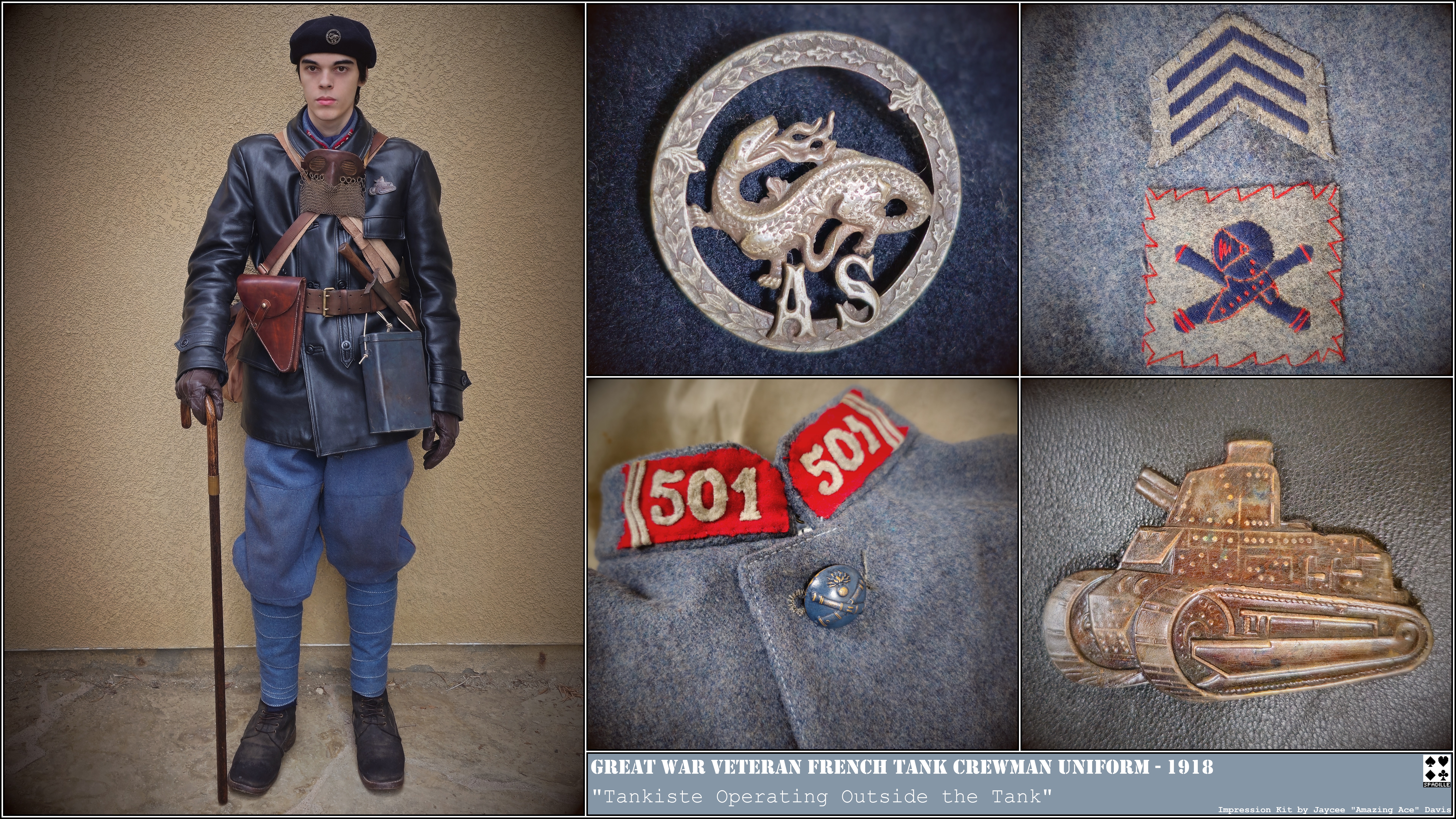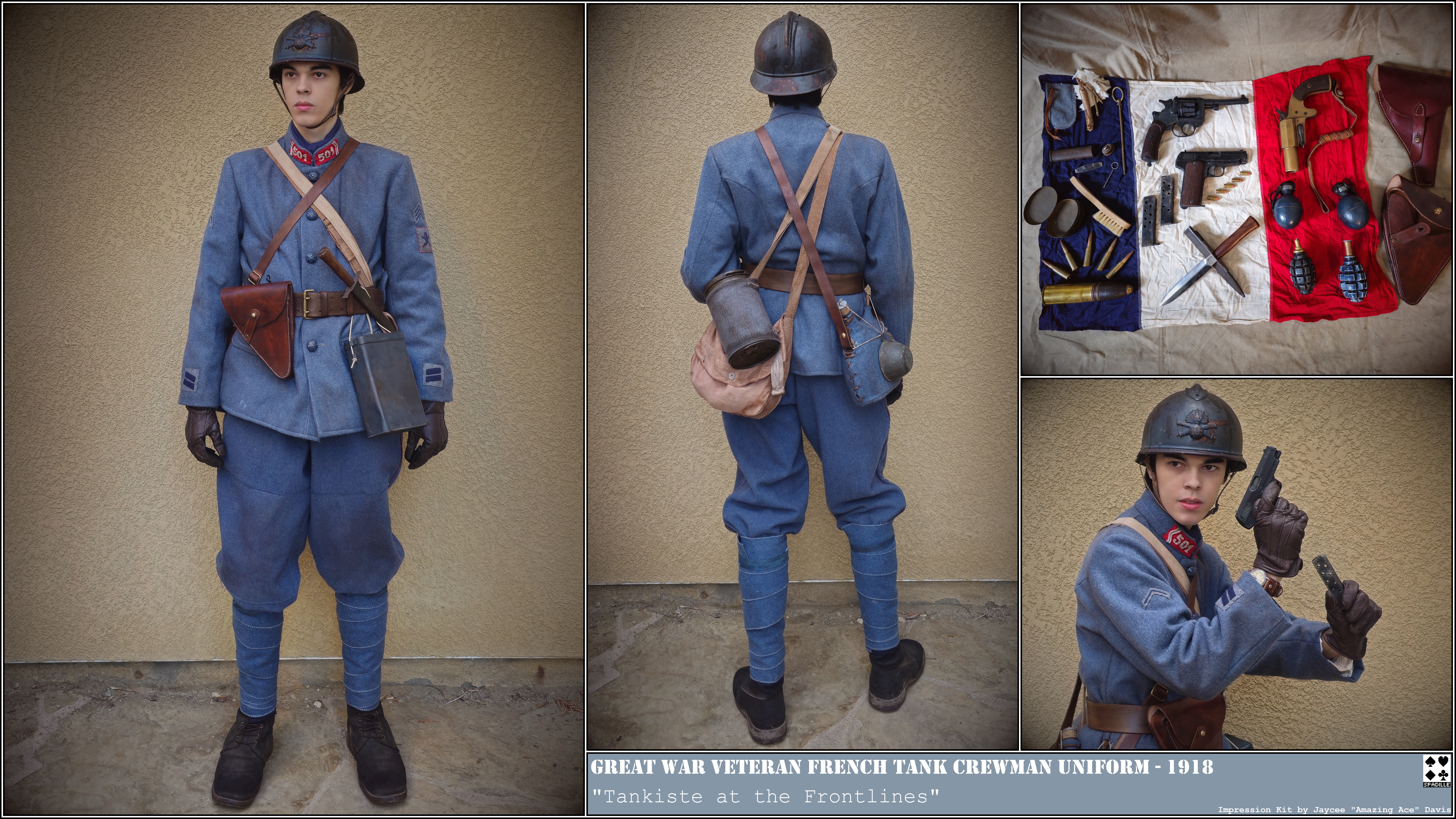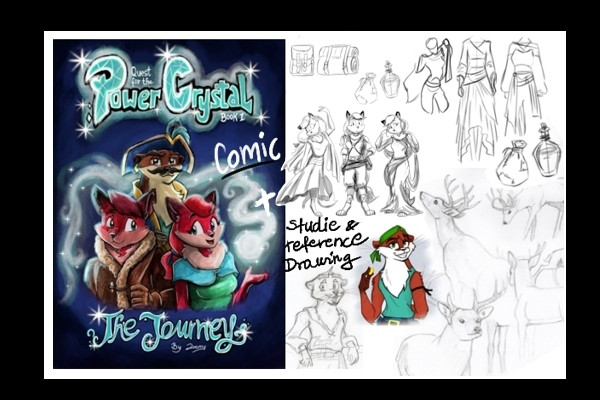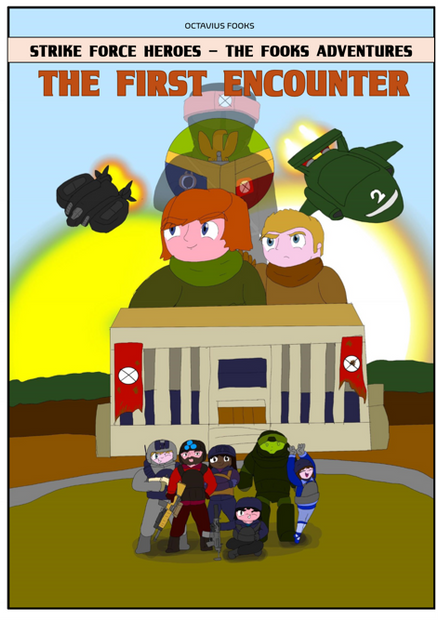HOME | DD
 Amazing--Ace — Tankiste on Leave
by-nd
Amazing--Ace — Tankiste on Leave
by-nd
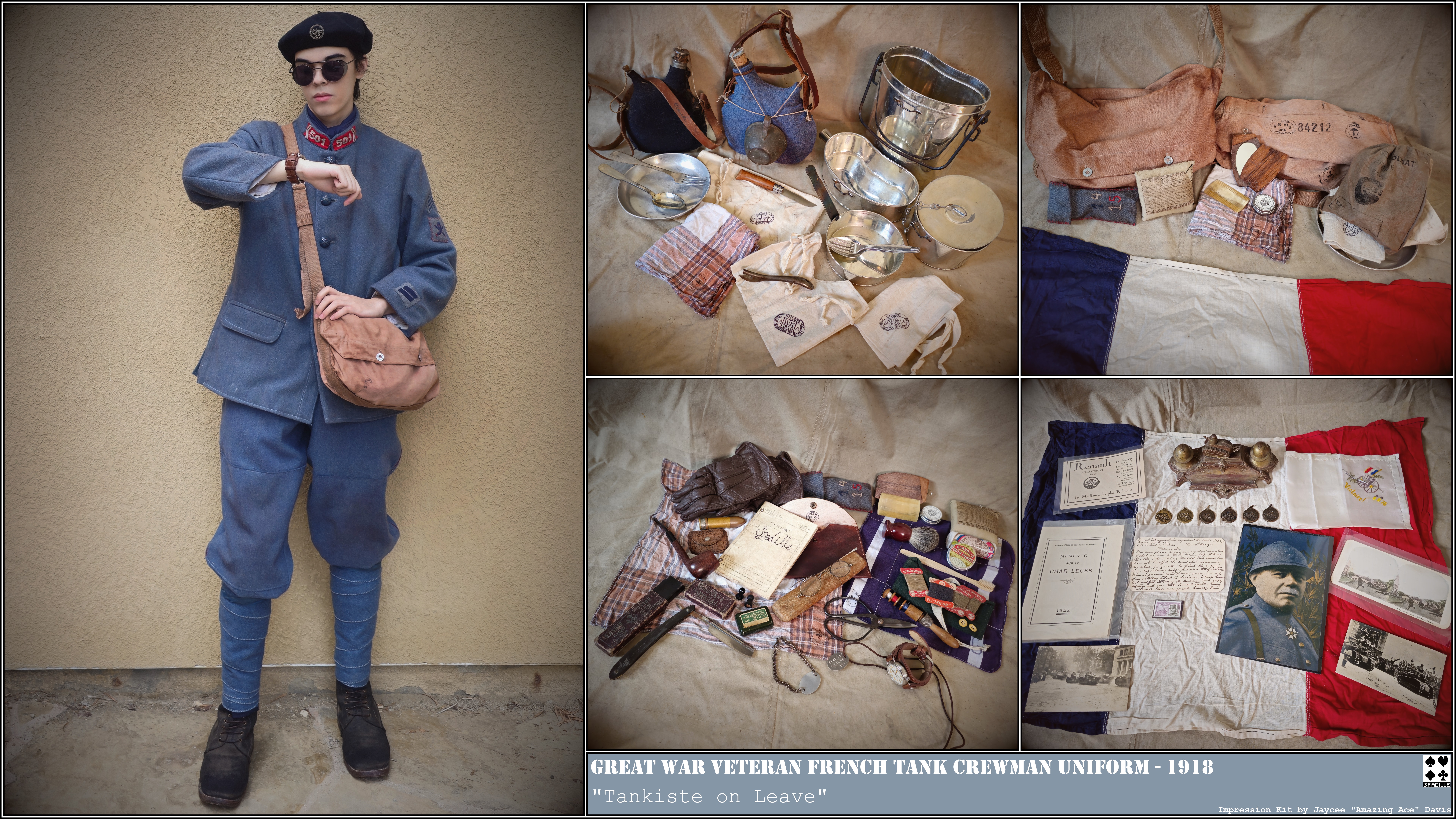
#history #reenacting #reenactor #tacticalgear #military #reenactment #uniform #worldwar1 #worldwarone #ww1 #ww1worldwar
Published: 2024-02-09 23:22:36 +0000 UTC; Views: 1204; Favourites: 4; Downloads: 0
Redirect to original
Description
This is an impression of a French tank crewman on leave. One may see this uniform on tankiste who have been granted leave to get some much needed rest. The only military items permitted on leave was the basic light blue wool uniform, cloth headgear, and Étui-Musette Modèle 1892 for their personal belongings (sometimes belts and helmets can be seen as well). Weapons and other combat equipment would be left with the unit Quarter-Master. The sunglasses are based off a 1913 US patent, and while not a widespread item to have among the French populace, sunglasses existed during the time period and were worn by few.The first display depicts the common tinwork and mess items one can see the Poilu using. We can see the two issued canteens in their wool covers intended to mask the shine of the tin. To the right of the canteens is a Bouthéon, or Camp Stew Pot, intended to carry soup rations for a section of soldiers. Four of these stew pots were issued to a squad and they could provide soup rations for four people. Despite the name, this tin was used for cooking and transporting soup as well as coffee and wine. The lid doubles as a pan with a protruding conical piece that accepts a wooden handle. When not in use it was to be worn at the back of the soldier's pack secured by the large load strap. A designated ration or soup carrier holding two of these tins as well as several bread bags and canteens sent to supply the frontline was a common sight to see.
Immediately below the Bouthéon is a Gamelle Modèle 1852, a mess kit issued to the individual soldier. This would be the main tin used for eating rations. It features a smaller pan that rests inside and a detachable handle that can be fixed to this pan. The lid of the mess kit is secured by a chain. This pan and handle are shown to the left of the gamelle. Inside the pan is a camping spoon and fork which was a common private purchase item at the time. Further to the left of this is an Opinel folding knife and standard issue can opener. The can opener was standard issue while the folding knife would be purchased in the civilian realm. Below these small kit items are canvas bags intended to hold dry rations. The double ration bags are intended to carry roasted coffee in one side and sugar in the other. The larger ration bag could carry bread or canned food. Immediately below the one liter canteen is the regulation cutlery. This included the spoon and fork while the tin plate was a common civilian model requisitioned for use within the Army.
The second display photo shows an example of contents within the Étui-Musette Modèle 1892 for this particular tankiste. These bread bags were intended to carry the soldier's rations and personal items. From the left to right we can see a pouch for glasses, an individual first aid kit, a handkerchief, a Double Toothed Comb, Lip Balm, Pocket Mirror, and assorted canvas bags. The double-sided comb was primarily to issued combat lice which would be a prevalent issue in the trenches. A nice pocket mirror is always good to have, this version protects the mirror in a wooden case. Other examples can be seen such as a simple round or rectangular model with metal backing issued in a canvas envelope.
The bottom left display photo shows more small kit items that could also be seen, with personal effects like a smoking pipe and trench watch, grooming items like the regulation razor and shaving items, toiletries like a toothbrush, and the standard issue sewing kit with scissors. Nothing much to be said here as it is universally understood as to why one would carry these items. Note however that the shaving kit and tooth care items were not standard issue and needed to be purchased separately by the soldier in military bazaars. The soldier's ID booklet and ID tags can also be seen. Every enlisted soldier would receive an identification booklet once they were incorporated into the military. It was to be carried at all times from the day of their incorporation into active service until discharge from the reserves. It would then have to be kept safe as a civilian in order to prove that they had completed their service obligations to the military. The booklet was to be worn on the soldier at all times. As a tankiste, the booklet would be carried within the interior breast pocket of the black leather motorist coat if this was worn. In all other cases it would be worn on the interior breast pocket of the wool tunic. It was often placed inside a wool or leather case in order to protect it from damage. The booklet contained everything to know about the soldier, from their mobilization class year, to their measurements and full name, to civil and military status including campaigns fought, awards, wounds, specializations, vaccinations, visa for military police, and much more.
The identification tags would be issued to all soldiers in order to properly identify their body when they died in battle. By the time of the AS, soldiers would often have two of these ID tags with one worn on the wrist via chain and the other worn around the neck secured by a spare boot lace. Other fashions and methods of wearing these tags would be seen as well. These are Plaque d’Identité Militaire Modèle 1915 variants specifically. The wearer's name and mobilization class year was stamped on one side with the recruitment region and recruitment number on the other side (the unstamped wrist tag is an original unissued example).
The bottom right display showcases various Artillerie Spéciale memorabilia. These are all post-war examples because the AS would get their due recognition in helping end the war in the years after the armistice. This was because after the war General Estienne and Louis Renault were heralded as war heroes who were able to take the military and civilian circles of the French bureaucracy and have them agree on the right path to take in regards to the creation of the French tank force and the doctrine of numerous light tanks swarming the enemy over the predominant idea of large landships. The Renault FT itself would be nicknamed 'Le Char de la Victoire' (The Victory Tank) because of the impact its use had in stopping the German Spring Offensive and their effectiveness in the battles leading to the end of the war. This nickname would make an appearance on medals awarded to factory workers who aided in constructing the Renault FT at the Billancourt factory. At the war’s end, France was in celebration after years of hardship and violence. As Louis Renault was awarded the Grand Cross of the Légion d’Honneur for his company’s contributions to the war effort, his workers were also given medals for their hard work in physically constructing the machines. This medal was commissioned and designed by the famous French sculptor Pierre Félix Masseau. His task was to create a medal that commemorated the successes of the Renault FT during the Great War. His design was 27 mm in diameter and featured a depiction of the Renault factory’s main product during the war: the Renault FT. The front of the medal depicted a Renault FT crushing the German Eagle with the caption “LE CHAR DE LA VICTOIRE. 1918” (The victory tank. 1918) above it. The back of the medal depicts the Renault Billancourt factory in a bird’s eye view. The maker’s mark is on the Renault FT side to the right of the tank. Three versions of the medal exist in gold, silver, and bronze. Silver versions feature the Boar’s Head poinçon denoting pure silver on the reverse along the integral loop. All versions feature the same design on the front and back and have the marking “Argent” on the rim of the medal. These medals would be offered to workers of the Renault Billancourt factory by the management after the armistice in 1918. Six original gold and bronze medals are presented here.
To the left of this is a 1919 Renault advertisement taken from a newspaper. From 1919 to 1923 Renault had changed its logo to the Renault FT as it had become their most famous product. It would appear on commercial tracked tractors and other Renault vehicles. Below this is a 1922 French Army pamphlet which outlines the unit organization and vehicle specifications of the Renault FT. And once again below this pamphlet is a photograph of 507e RAS operated Renault FT on parade in Wiesbaden, Germany, 1919, during the post-war occupation of the Rhine region. All AS units that were collectively awarded the Croix de Guerre after the war had the medal painted on the left front side of the turret on their FT inside the white geometrical shape of their company, sometimes bordered in red. We can faintly see the medal painted inside a white triangle on these tanks. To the right of this is an original May 1921 letter hand written by General Estienne himself. He is writing to a prominent American woman who asked what his opinion was on the American Tank Corps' performance during the Great War. Beside the letter is an original stamp and magazine cover from Le Pays de France depicting the French Father of the Tank. On the right we can see an original armistice handkerchief depicting the famous Canon de 75 modèle 1897. Immediately below this is a stereograph depicting AEF forces and their tanks fighting in the Ardennes in 1918. Placing this photo in a stereoscope would produce a 3D effect for the viewer.
These paper items are wrapped in museum-grade UV protective film. Here's hoping that they will survive in perfect condition status for another 100 years!
Related content
Comments: 2

👍: 1 ⏩: 1

👍: 0 ⏩: 0
